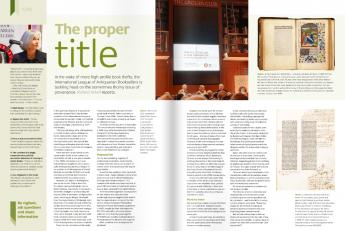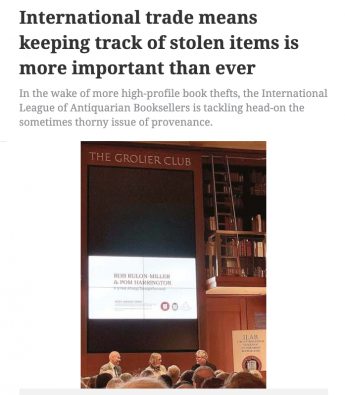News & Updates
International trade means keeping track of stolen items is more important than ever

This article is republished here with kind permission of Antiques Trade Gazette.
In her opening remarks at a symposium titled Who Owned This?, Sally Burdon, president of the International League of Antiquarian Booksellers (ILAB), outlined the issues faced by libraries and the rare book trade on the topic of provenance, theft and forgery.
“The popular image of an old bookshop is not the modern reality. Antiquarian books, manuscripts, maps and prints are constantly being traded across international borders. Because of this, identifying and keeping track of stolen items is ever more important and requires immediate response.”
There has been a reluctance to talk about stolen books in the market, but book thefts are not a new phenomenon. In the 1840s, the Italian count and mathematician Guglielmo Libri Carucci dalla Sommaja abused the privileges of his position as Chief Inspector of French Libraries to steal the 30,000 rare books and manuscripts that later funded a comfortable life in London society.
However, the March 5 meeting this year at the Grolier Club in New York, the oldest existing bibliophilic club in North America, was timely. It followed a sense that changes in protocol may be required after a succession of high-profile cases, including an alleged $8m theft from Carnegie Library in Pittsburgh. John Schulman, co-founder of local dealership Caliban Book Shop and Greg Priore, who had worked as the archivist and manager of the Carnegie’s rare book room since 1992, were charged in July last year with theft, receiving stolen property and forgery. While both men await trail, a list of 314 missing books has been circulated.
There can be a tendency in the wider media to pigeonhole this type of theft as the stuff of white-collar eccentrics or Thomas Crown Affair ‘heists’ rather than a straightforward crime as well as an attack on cultural heritage.
The theft in February 2017 of more than 160 rare books and manuscripts including a 1566 copy of De Revolutionibus Orbium Coelestium by Nicolaus Copernicus destined for the 50th California International Antiquarian Book Fairwas reported in mainstream media complete with diagrams of how ‘Mission: Impossible raiders’ using abseiling gear entered a depot near Heathrow via a skylight.
Financial hit
For the overwhelming majority of professional booksellers, stolen books, or those with title issues, are a source of misery rather than anything in the way of opportunity.
As well as the vandalism that can befall a stolen book – huge damage is done when plates are cut out or telltale bookplates, bindings and stamps removed – it is invariably the dealer who buys and sells in good faith who takes a financial hit when a book is later returned to its rightful home.
There would be expensive consequences for the dealers and collectors who unwittingly became tangled in the web of the Carnegie debacle. A copy of the first edition of Isaac Newton’s Philosophiae Naturalis Principia Mathematica published in 1687, bought by Peter Harrington for £72,500 and sold to a London private collector more than five years ago for £145,000 was recently restituted back to Pennsylvania at the dealer’s own expense.
What could be done to improve the situation?
Number one on the wish list of most dealers and auctioneers is that libraries and institutions conduct regular inventory inspections (it is common refrain in many high-profile cases that ‘libraries did not even know any books were missing’) and report missing items immediately. In the case of the Carnegie Library it emerged that an inventory had not been conducted for 26 years – the loss of some of its most commercially valuable bibliographic treasures in the intervening period only noticed during a long-overdue insurance appraisal in April 2017.
Embarrassed by any suggestion of lax protocols and any negative publicity that could be a threat to future donations, libraries are not always forthcoming in notifying the police or the book trade of missing items. When in 2004 the request to see an early map of the Mississippi at the Royal Library of Sweden led to the unravelling of a $5m theft, the library failed to publish a list of 56 missing items.
It was not until eight years later that a member of the library staff noticed a copy of the rare Wytfliets Atlas, posted for sale at Arader Galleries in New York. It had been in stock, available to view on the firm’s website, since its purchase at Sotheby’s in 2003.
Hard to trace
Not everything is quite so easily identified and – as conference delegates heard – not every country operates under a legal system where title for stolen property can never pass.
As most books and maps are multiples, they can be hard to trace back when they are sold, particularly when transacted online or moved overseas.
In this context a library can also help itself by making its books more easily identifiable – recording copy-specific details and marking books appropriately with small non-disfiguring but indelible stamps of ownership.
Cautionary tales on the subject were heard by the audience throughout the day at the Grolier. A discussion conducted by Burdon with dealers Rob Rulon-Miller and Pom Harrington under the title It’s Not Always Straightforward explored what constitutes good practice and due diligence within the trade when making a purchase.
Again, the adherence to a strict code of practice is important: checking the book against the available lists of stolen material, requesting photo ID and settling by digital wire transfer rather than by cash or cheque. Any signs of prior institutional ownership should be followed up.
There are many legitimate books in the marketplace with old institutional marks (deaccessioning is a common practice) but many booksellers will seek to double check with the institution concerned.

Of course an extensive provenance is not always possible.
The histories of prior ownership now requested by some institutions when considering even a minor purchase can be unrealistic – and Rulon-Miller is surely correct when he concludes “there may always be an element of relying on people’s good word and honesty and exercising some common sense”.
But actively taking steps to firm up history of ownership is the key role of any 21st century bookseller. It pays to have an answer the next time someone asks ‘who owned this?’.
